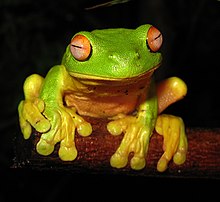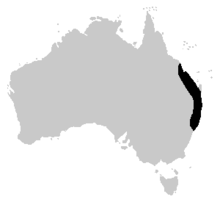
The Australian green tree frog, also known as simply green tree frog in Australia, White's tree frog, or dumpy tree frog, is a species of tree frog native to Australia and New Guinea, with introduced populations in the United States and New Zealand, though the latter is believed to have died out. It is morphologically similar to some other members of its genus, particularly the magnificent tree frog (R. splendida) and the white-lipped tree frog (R. infrafrenata).

Peron's tree frog, also known as the emerald-spotted tree frog, emerald-speckled tree frog, laughing tree frog, and maniacal cackle frog, is species of tree frog in the subfamily Pelodryadinae. It is a common frog found in Australia.

The magnificent tree frog, also known as the splendid tree frog, is a species of tree frog first described in 1977. It has a limited range, only occurring on the north-western coast of Australia in the Northern Territory and Western Australia. It has a similar appearance to, and can be confused with, the closely related White's tree frog.

Tyler's tree frog or the southern laughing tree frog is an arboreal species of tree frog. It is native to eastern Australia where it occurs from south-eastern Queensland to the southern coast of New South Wales. It is generally a coastal species and is not found inland.

The bleating tree frog, also known as Keferstein's tree frog, is a species of tree frog in the subfamily Pelodryadinae. This frog is native to coastal eastern Australia, from south-eastern Queensland, to around Eden, New South Wales.
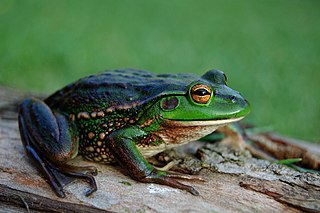
The growling grass frog, also commonly known as the southern bell frog, warty swamp frog and erroneously as the green frog, is a species of ground-dwelling tree frog native to southeastern Australia, ranging from southern South Australia along the Murray River though Victoria to New South Wales, with populations through Tasmania. This species' common names vary between states; the name southern bell frog applies to New South Wales, growling grass frog in Victoria and South Australia, and green and gold frog in Tasmania. This species has been introduced to New Zealand.

The Blue Mountains tree frog also called the variegated river tree frog is a species of tree frog in the subfamily Pelodryadinae. It is endemic to southeastern Australia and is found in eastern Victoria and in southeastern New South Wales. The Jenolan Caves tree frog, a population formerly separated as Litoria jenolanensis, is nowadays included in this species.

The leaf green tree frog is a species of stream-dwelling frog, native to eastern Australia from the Queensland/New South Wales border south to Sydney.

The whistling tree frog (Litoria verreauxii), or Verreaux's tree frog, is a species of frog found in Australia. It has been divided into two subspecies, the nominate Verreaux's tree frog and the Verreaux's alpine tree frog. The alpine tree frog is restricted to the southern alps of New South Wales and Victoria. Verreaux's tree frog is widespread throughout south-eastern Queensland, coastal and highland regions of New South Wales, and south-eastern Victoria.
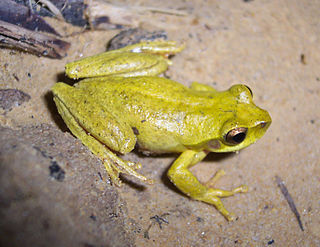
The revealed frog, whirring tree frog, or orange-thighed treefrog is a species of tree frog native to coastal eastern Australia.

The southern brown tree frog, also known as the brown tree frog, whistling tree frog, or Ewing's tree frog, is a species of tree frog native to Australia: most of southern Victoria, eastern South Australia, southern New South Wales from about Ulladulla—although this species is reported to occur further north—and throughout Tasmania including the Bass Strait Islands, in which state it is the most frequently encountered frog. It has been introduced to New Zealand, where it can be locally abundant.

The mountain stream tree frog is a species of tree frog native to highland areas of NSW, Australia stretching from the Myall Lakes area, north to around Dorrigo National Park and west to Barrington Tops National Park.

The dainty green tree frog, also known as the graceful tree frog, is a species of tree frog in the subfamily Pelodryadinae. It is native to eastern Queensland, and north-eastern New South Wales, Australia and ranges from northern Cape York in Queensland to Gosford in New South Wales, with a small and most likely introduced population in Hornsby Heights in Sydney. It is the faunal emblem of the City of Brisbane.

The motorbike frog is a ground-dwelling tree frog of the subfamily Pelodryadinae found in Southwest Australia. Its common name is derived from the male frog's mating call, which sounds similar to a motorbike changing up through gears; it is also known as Moore's frog, the western bell frog, western green and golden bell frog, and western green tree frog.
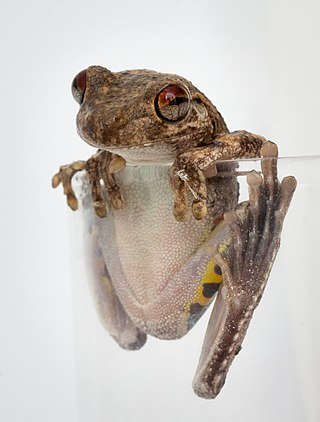
Roth's tree frog, or the northern laughing tree frog, is a species of tree frog native to northern Australia and southern Papua New Guinea. Roth's tree frog is a common frog, closely related to Peron's tree frog and Tyler's tree frog.

The orange-thighed frog is a species of tree frog native to a small area of tropical northern Queensland, Australia. It is a green frog with distinctly orange eyes, and is very similar in appearance to the red-eyed tree frog.

The rough frog, also known as the woodland water-holding frog, warty water-holding frog, and red-backed cyclorana, is a species of treefrog native to northern New South Wales and south-eastern Queensland, Australia.
"Litoria" castanea, also known as the yellow-spotted tree frog, New England swamp frog, tablelands bell frog, or yellow-spotted bell frog, is a species of frog in the subfamily Pelodryadinae. It is a critically endangered species of frog that is endemic to south-eastern Australia.
The spotted-thighed tree frog is a species of tree frog in the subfamily Pelodryadinae, found in Western Australia.

Ranoidea wilcoxii, also known as the stony-creek frog, eastern stony creek frog, and Wilcox's frog, is a species of frog in the subfamily Pelodryadinae. It is endemic to Australia, being found solely on the eastern coast between Ingham, QLD, and Sydney, NSW, and as far west as Atherton, QLD. Its natural habitats are subtropical or tropical dry forests, subtropical or tropical moist lowland forests, rivers, intermittent rivers, and pastureland.
